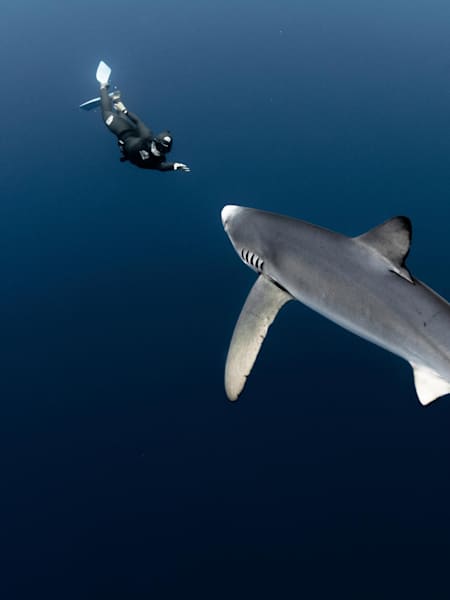French freedivers Alex Roubaud and Alex Voyer have a passion for diving in some of the world's most remote locations, capturing the incredible life that lurks beneath. From sharks to rays to leopard seals, the Paris-based pair believe that holding their breath is the best way to interact with sea life.
“Freediving leads us to see the world differently than a traditional scuba diver,” says Alex Voyer.
Keep scrolling to see his incredible world.
“Freediving is probably the most environmentally friendly and most discreet way to approach any animal – in the water, in its environment. This approach gives a different perspective to underwater classical photos,” says Alex.
“We are also much more free in the water than with tanks on the back. We can perhaps not go as deep, but we can dive faster in all three directions. We can also stay much longer in the water – a trip can last three to four hours.”
The pair are based in Paris which offers limited options for freediving. “When we have a little time, and with the agreement of our banker, we pack our bags to go anywhere there is a little water.”
Although the shots posted here were taken from Antartica to the Azores, their trips are often closer to home, like on Brittany's coastline.
“Our coasts are really beautiful, but we try to go anywhere around the world to meet wonderful sea creatures that fascinate us!”
One of the attractions for freedivers is the sport's simplicity. All you need is a wetsuit, a mask and some fins. An ability to hold your breath is useful too.
Want to know how to hold your breath for five minutes? Check out what they teach at the Red Bull high performance camp.
While the pair made a trip to Antarctica in 2013, they're also fans of warmer waters such as those around the Maldives and the Azores. Sun, abundant sea life. And we're sure much else besides...
A highlight for the guys without question was diving with whale sharks, the largest fish in the world. In the shot above, Marianne Aventurier dives underneath one of the majestic creatures in the Azores.
“It was one unforgettable moment, for sure!” says Alex.
Alex Voyer becomes hypnotised by a pool of jacks (above) off Malpelo Island Colombia earlier this year.
The small, uninhabited island lies about 500km off the coast of Colombia in the East Pacific Ocean. Just over a kilometre in length and 600m wide, it's a barren rock with three peaks, the highest being 300m above sea level.
Humans are uniquely adapted to freedive. The so-called 'mammalian reflex' kicks in when we enter water and lowers our heart rate. This is essential for conserving oxygen and holding breath for long periods.
Another reflex that kicks in during a dive is 'vasoconstriction' when blood flow retreats from extremities like hands and feet to preserve vital organs.
Professional freedivers can stay down for three to four minutes although most recreational dives are much shorter.
As serene and beautiful as it looks, freediving has the potential to be dangerous. In the last 10m of a dive, when the pressure difference is at its greatest, shallow water black outs are not uncommon. This is when divers literally pass out.
Left alone, the result can be fatal. For this reason, freedivers will always buddy up.
“Freediving is not a dangerous activity as we respect the elementary rules of safety, and diving with a buddy is the first and vital rule,” says Alex. “We encourage anyone who wants to try free-diving to approach competent instructors, and never freedive alone!”
The Maldives is a diver's paradise. The chain of islands offers warm waters and abundant sea life.
“We only use natural light and only our breath to shoot our photos,” says Alex. “It is why there are not so many colours. But this is exactly how it was for us, seeing at this instant.”
A highlight for the guys was the freediving trip to Antarctica. The cold water provide plentiful sea life, including a unique chance to play hide and seek with a leopard seal. But this is no cute playmate. Leopard seals are the biggest predators in Antarctica and have a ferocious reputation.
“This was certainly the first freediving trip organised in Antarctica,” says Alex. “We were living in a 52ft sailing boat during one month to obserse all the differents animals living there.”
“It was really impressive to dive in thoses waters surrounded by high mountains, so far from human civilisation!”
Like this? Get more adventure direct to your tablet or smartphone by downloading the App here.














